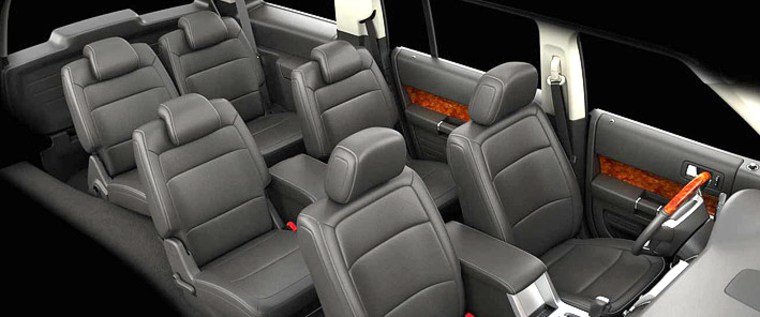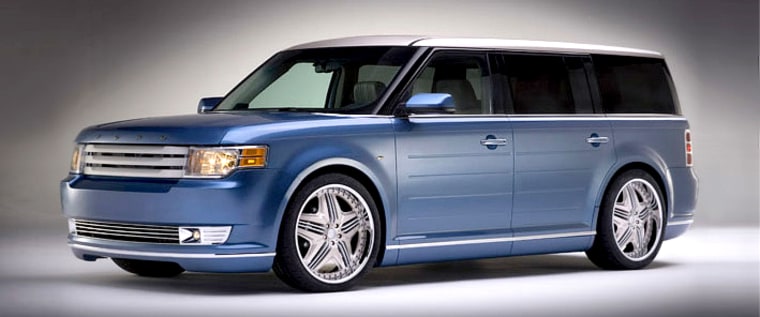Despite the constant changes in American daily life, one ritual has changed little in the last century — the neighborhood summer cookout.
And there’s no better time or place to litmus test Ford’s dramatic new Flex family car. At one summer cookout in my neighborhood recently I polled friends and neighbors for their views on the Flex. After all, everyone in holiday cookout land drives a family vehicle, be it a minivan, a big, old truck-style SUV, or a newer, car-like crossover.
The verdict was an overwhelming landslide endorsement of Flex’s blocky styling. One mom said it looked too much like a hearse, while 12-year-old Matt, a seventh grader, called it a “loser minivan.” But those were the only negative remarks I encountered.
The most flattering evaluations thought the Flex recalled vintage surf wagons, suggesting it would look natural with a couple boards on the roof. This suburban survey was critical to guessing the Flex’s future, because with this car Ford is treading into unknown territory.
That’s because the Flex is impossible to pigeonhole. It isn’t a Jeep-wannabe SUV, it isn’t a minivan, and it isn’t one of the cuddly, soft-edged new generation of crossover SUVs. It has a bold, almost haughty, visage that defies classification. And this can cause shoppers to overlook a product when they draw up their shopping list.
One cookout companion had actually tested a Flex at the dealer the day before, and I asked her what kind of vehicle she thought it was.
“The dealer said it is a crossover,” she replied, “but I don’t even know what that means.”
This would be worrisome if the styling verdict wasn’t so overwhelmingly favorable. Ford has taken this chance before. When the company introduced the 1986 Taurus, the car brought avant-garde styling to the masses and established Ford as Detroit’s style leader for a decade, until Chrysler snatched that title away.
Like the Flex, the Taurus sought to introduce mainstream family car buyers — usually the most conservative of customers — to a new design aesthetic. Groundbreaking design is the purview of urban fashionistas, not suburban moms and dads. Attempting to sell high style in high volume is a risky business.

But Target has shown that middle-of-the-road suburbanites can embrace fashion when it’s matched with solid quality and affordable prices. The same consumers who snap up Target’s Michael Graves-signature products for their homes seem ready to consider the Flex, just as their parents embraced the Taurus a generation ago. But times — and people — change, so it’s impossible to be sure. After all, in 1986 Sarah Palin and Keith Olbermann were both sportscasters.
The complication in this calculation is the price of gas. If it had remained under $3, as was expected when the Flex was in gestation a few years ago, the vehicle would probably now rank alongside the iPhone as one of the most sought-after consumer goods of the year. It may yet achieve that status. Yahoo reported that Flex was among its top ten searches by consumers in July, and heads turned everywhere I went with my test vehicle.
But pricey gas has consumers reconsidering plans to buy three-row, seven-seat vehicles, and it’s making them think about downsizing to something smaller and less thirsty. This reluctance on the part of consumers to commit to vehicle of the Flex’s size and fuel economy is the only obstacle to it becoming a success along the lines of the original Taurus and Chrysler minivan.
The EPA says the front-drive version of the Flex will get 17 MPG around town and 24 MPG on the highway, while the tested all-wheel-drive version is rated 16/22 MPG. In a week of driving around suburbia, I got 17.5 MPG, suggesting the front-drive version would match the 18-19 MPG I normally see in minivans and front-drive crossover SUVs.
Just as the exterior has a panache that’s unexpected from Ford, so the interior is an aggressive move upmarket. The Limited version of the Flex I tested was trimmed in leather that looked pretty nice, but which failed to convey through sight, touch or smell the opulent feeling that leather should provide. A cabin with seven leather seats should look, feel and smell like a back room at a country club. The Flex’s just seems like a nice interior.
The instrument panel and dashboard, at least, seem to belong to a more exclusive class of car. Gone, at long last, are the cheapo Pep Boys gauges and LED displays that Ford has seemingly used since the dawning of the age of the Taurus. Here again, this affordable fashion is reminiscent of Target’s products.
No one will mistake the Flex’s instruments for those of a Mercedes, but these are acceptably good knock-offs for the car’s price ($43,250 for the Limited AWD version I tested, about half the price of a comparable Mercedes station wagon).
The Flex’s second and third rows of seats are spacious and comfortable, and they’re also cleverly designed to fold away. The second row slides fore and aft to balance second row and third row legroom, as needed, and the seat backs recline for comfort. The third row of seats is conveniently accessible because the second row seats flip forward and out of the way. Once seated, occupants will find that the third row is even sufficiently roomy and comfortable for adults, with more legroom and better thigh support — that’s not typical for seats in the way back.
Just as importantly to some drivers, the third row seats fold flat to provide cargo space. Even when the seats are raised there is a useful 20 cubic feet of cargo space behind them thanks to a deep cargo well behind the third row.
The Flex is nearly as practical as a van, and could be improved on only with the substitution of sliding second-row doors for the hinged doors on the Flex. Ford examined that possibility for the car, but found that vain consumers would buy only a fraction as many Flexes if the otherwise identical vehicle were equipped with sliding doors, presumably because it would look too much like a minivan.
So instead everyone who parks next to one in a parking lot will be at risk that the tots exploding out of the Flex’s back seats won’t remember not to fling the doors open to dent the adjacent cars.
The Flex shares its underlying hardware with the competent but unexciting Taurus and Taurus X (previously known as the Five Hundred and Freestyle), and it delivers the same safe-and-responsible driving experience. We could hope for a little responsiveness to the driver, as delivered by the Honda Odyssey, but instead get the car-as-transportation-appliance experience of a Toyota. At least the power steering has some heft and feedback that has been eliminated from Toyota’s products.
The Flex’s engine, however, quickly reminds the driver that there is machinery at work. Especially under hard acceleration, the 3.5-liter Duratech V-6 is coarse and loud. This is not a deal-breaking shortcoming, but it is disappointing that Ford still seems unable to sweat the details on powertrains that rival any competitor with their specs on paper, but don’t measure up in the real world.
The Flex’s six-speed automatic transmission is well tuned, and the throttle, brake and steering are all correctly calibrated so that it’s easy for the driver to navigate smoothly at parking lot and suburban speeds without any unexpected lurches. Delicacy of control during light application of the pedals is a seemingly obvious but too-often overlooked detail that Ford got right with the Flex, and it’s an important detail when hauling passengers who don’t need any extra help spilling their drinks or snacks in the car.
No one dropped their burger on the ground during the cookout I attended, but there was one ketchup-on-the-new shirt incident. And after enough discussion I was able to identify the Flex’s species: It’s a freshly-evolved member of the North American family station wagon family, a variety previously thought to be extinct. I thought only the surfers with their vintage “woodies” knew station wagons could be cool-looking cars, but congratulations to Ford for figuring that out.
